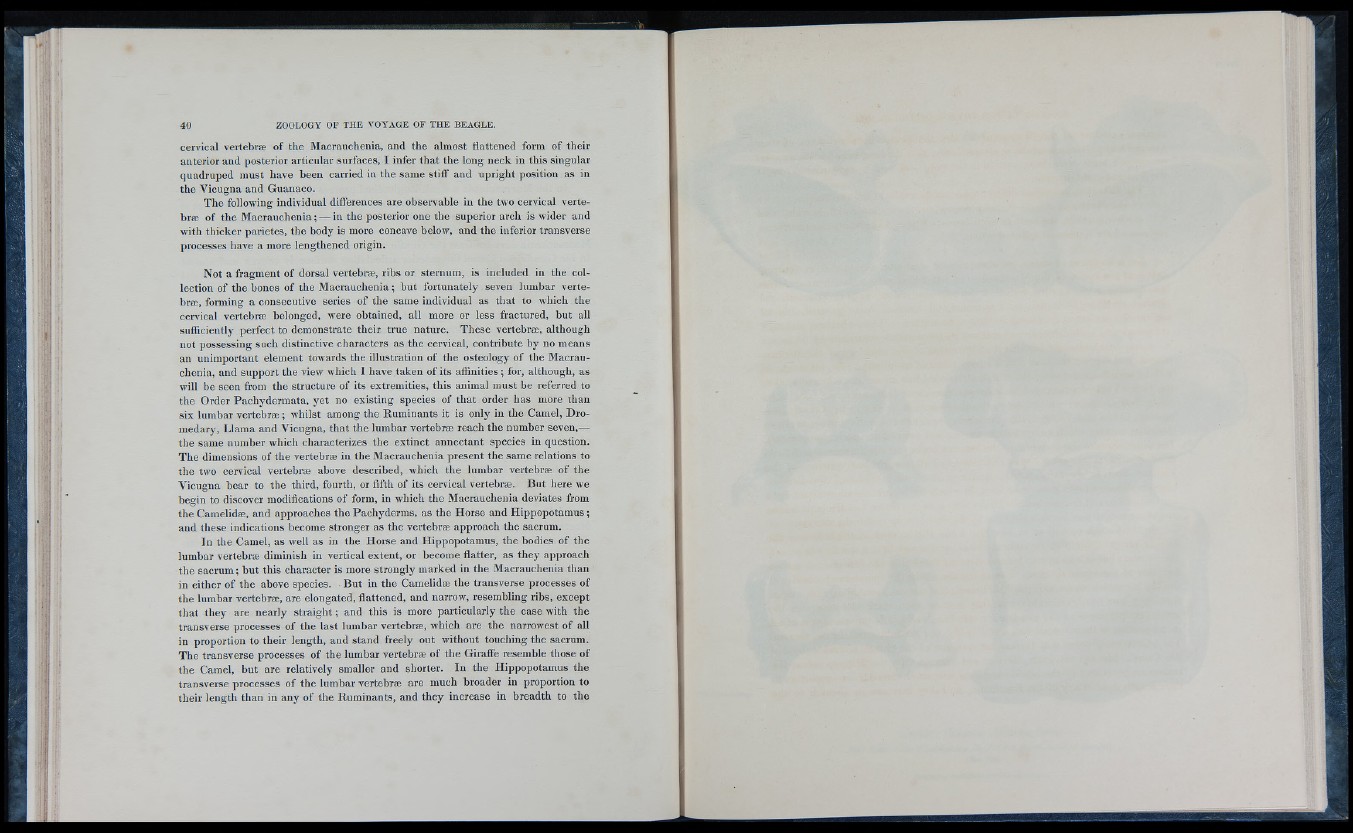
cervical vertebræ o f the Macrauchenia, and the almost flattened form o f their
anterior and posterior articular surfaces, I infer that the long n e ck in this singular
quadruped must have been carried in the same stiff and upright position as in
the Vicugna and Guanaco.
The following individual differences are observable in the two cervical vertebræ
o f the Macrauchenia; — in the posterior one the superior arch is wider and
with thicker parietes, the body is more concave below, and the inferior transverse
processes have a more lengthened origin.
N o t a fragment o f dorsal vertebræ, ribs or sternum, is included in the collection
o f the hones o f the Macrauchenia ; but fortunately seven lumbar vertebræ,
forming a consecutive series o f the same individual as that to which the
cervical vertebræ belonged, were obtained, all more or le ss fractured, but all
sufficiently perfect to demonstrate their true nature. Th ese vertebræ, although
not possessing such distinctive characters as the cervical, contribute b y no means
an unimportant element towards the illustration o f the osteology o f the Macrauchenia,
and support the view which I have taken o f its affinities ; for, although, as
will be seen from the structure o f its extremities, this animal must be referred to
the Order Pachydermata, y e t no ex isting spe cie s o f that order has more than
s ix lumbar vertebræ ; whilst among the Ruminants it is only in the Camel, Dromedary,
Llama and Vicugna, that the lumbar vertebræ reach the number seven,—
the same number which characterizes the extinct annectant spe cie s in question.
Th e dimensions of the vertebræ in the Macrauchenia present the same relations to
the two cervical vertebræ above described, which the lumbar vertebræ o f the
Vicugna bear to the third, fourth, or fifth o f its cervical vertebræ. But here we
begin to discover modifications o f form, in which the Macrauchenia deviates from
the Camelidæ, and approaches the Pachyderms, as the Horse and Hippopotamus ;
and these indications become stronger as the vertebræ approach the sacrum.
In the Camel, as well as in the Horse and Hippopotamus, the bodies o f the
lumbar vertebræ diminish in vertical extent, or become fiatter, as they approach
the sacrum; but this character is more strongly marked in the Macrauchenia than
in either o f the above spe cie s. B u t in the Camelidæ the transverse processes o f
the lumbar vertebræ, are elongated, flattened, and narrow, resembling ribs, exc ept
that they are nearly straight ; and this is more particularly the case with the
transverse processes o f the la st lumbar vertebræ, which are the narrowest o f all
in proportion to their length, and stand freely out without touching the sacrum.
The transverse processes o f the lumbar vertebræ o f the Giraffe resemble those o f
the Camel, but are relatively smaller a,nd shorter. In the Hippopotamus the
transverse processes o f the lumbar vertebræ are much broader in proportion to
their length than in any o f the Ruminants, and they increase in breadth to the